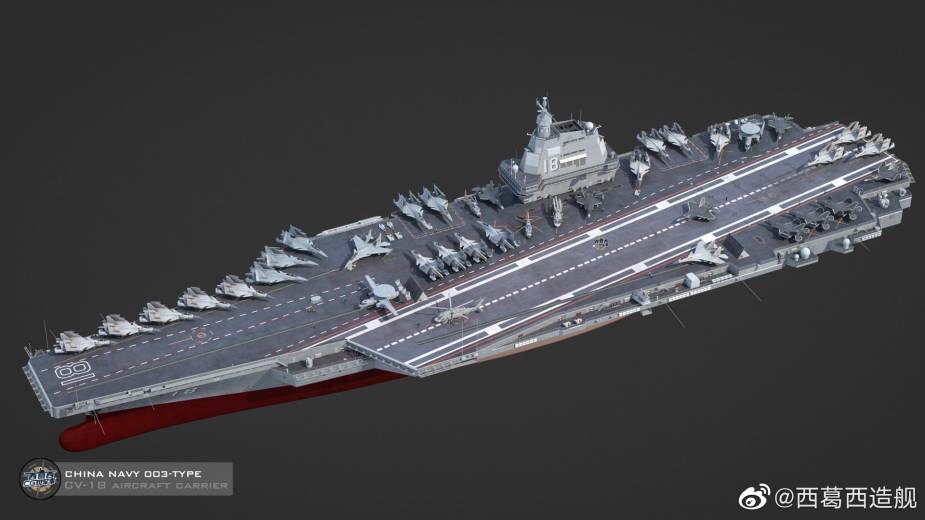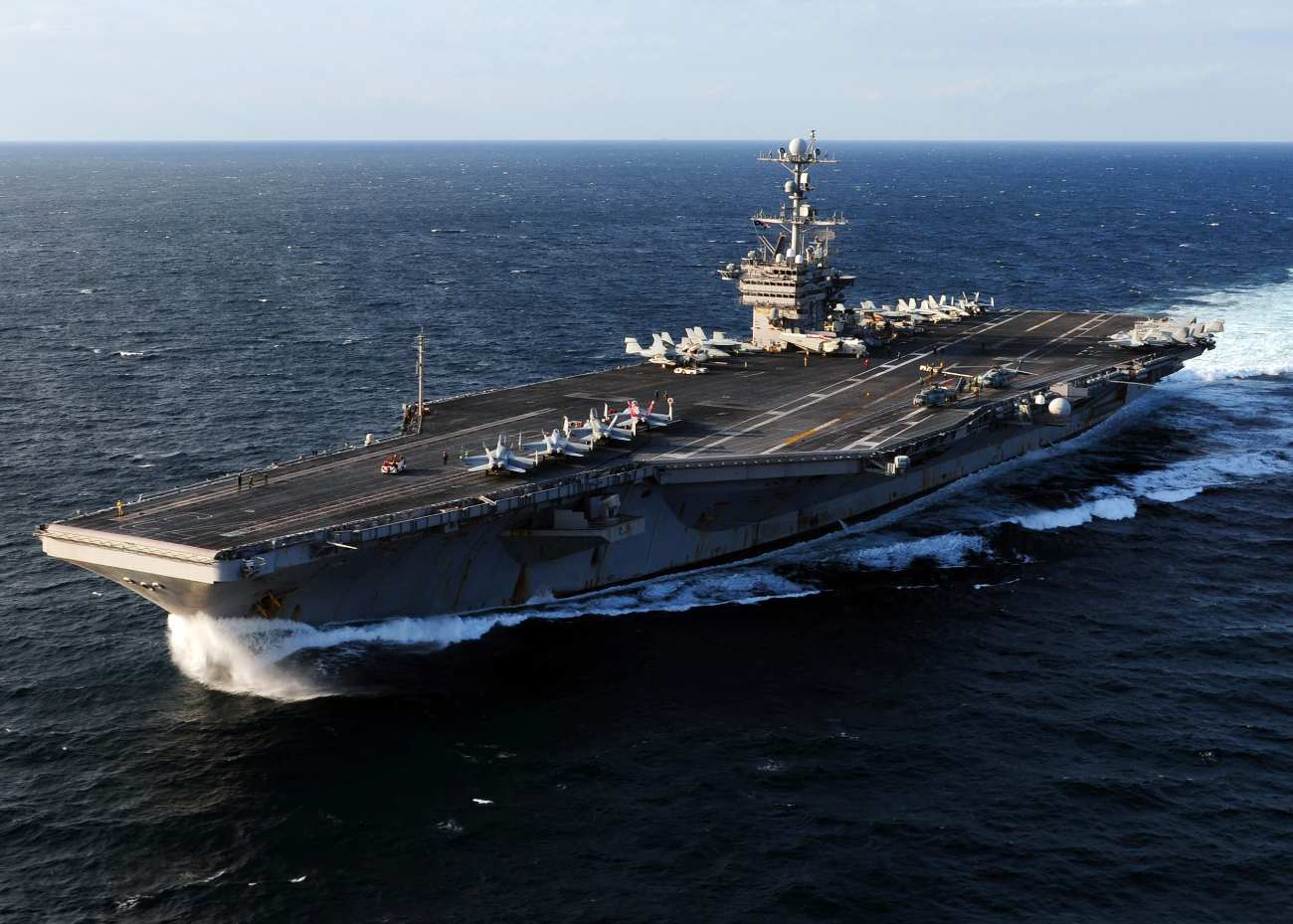The third and the most advanced “super-carrier” of China, Fujian, has started testing her electromagnetic catapult system, making it the second navy besides the US Navy to have the technology. This suggests the warship remains on course for its planned deployment in 2025.
Chinese military enthusiasts first shared footage of the “dead load” launch testing for her electromagnetic catapult system on the Chinese social media platform Weibo on November 26.
It subsequently made it to X. The video is recorded from an aircraft over the shipyard facilities where CNS 18 Fujian (Type 003 aircraft carrier) is currently berthed.
The Pudong Shanghai International Airport is very close to the shipyard, and videos and images taken by the passengers often provide progress reports on the 80,000-ton aircraft carrier, the country’s first one equipped with electromagnetic catapults and arresting devices.
The video shows the launch and drop of a test vehicle from one of the two forward catapult positions on the new aircraft carrier into the water of the basin in front of Fujian. This is called “dead load”-testing, which is common for all catapult-equipped aircraft carriers, including after major overhauls.
11月26日、003型航空母艦"福建(18)"が電磁カタパルトの射出テストを行い、これに成功したとのこと。
(via wb/@风清颂) pic.twitter.com/gN5nIGBQpt— お砂糖wsnbn (@sugar_wsnbn) November 26, 2023
Fujian is a key piece in China’s People’s Liberation Army (PLA) Navy’s pursuit to challenge the US Navy’s dominance. Fujian aspires to rival its US counterparts in terms of size and technology.
The testing was anticipated as satellite imagery of Shanghai Shipyard on November 19 suggested preparations for its maiden sea trials.
The Washington-based think tank, the Center for Strategic and International Studies, has been tracking the progress of Fujian using satellite imagery since 2018 under its project China Power.
Images from October 17, 2023, show workers have taken the long-expected step of removing the environmental shelters covering the ship’s three catapults, indicating that primary work on the systems is completed.
The observers are keenly waiting for the catapults, which will be the major departure from its first two carriers – the Liaoning and Shandong. The first two carriers rely on less advanced ski jump-style “short take-off, barrier arrested recovery” (STOBAR) systems.
The Fujian deploys a “catapult assisted take-off but arrested recovery” (CATOBAR) launch system. This represents a leapfrogging past more conventional steam-powered catapults.
The electromagnetic catapult will enable it to launch heavier and larger fixed-wing aircraft with greater fuel and weapons loads. The US Navy’s latest Gerald R. Ford-class carriers feature an electromagnetic catapult launch system.
The electromagnetic catapult also enables faster take-offs, increases energy efficiency, and reduces stress on aircraft frames during take-offs.

It enables the deployment of a wider variety of aircraft, encompassing both piloted and potentially unmanned options. This includes the capacity to launch transport aircraft and fixed-wing airborne early-warning and control aircraft, significantly enhancing the carrier’s operational versatility.
The Fujian is much bigger than the previous Chinese aircraft carriers. As against the Liaoning’s 60,000 tonnes and the Shandong’s 66,000, the Fujian displaces roughly 80,000 tonnes.
It is much bigger than France’s aircraft carrier Charles de Gaulle (42,000 tonnes) and the United Kingdom’s HMS Queen Elizabeth (65,000 tonnes). It is smaller than the US Navy’s Ford-class carrier, which displaces 100,000 tonnes.
The only technological disadvantage it has in comparison to the US and French carriers is that they are not nuclear-powered.
Experts opine that the carrier will undergo multiple rounds of manufacturer trials to test the hull’s soundness and maneuverability. “Once handed over to the PLAN, sailors will conduct their trials of its weapons, aircraft launch systems, and other capabilities in a process that will take months or even years,” the CSIS ChinaPower says.
The aircraft carrier will be operating J-15 T, the updated version of the J-15 fighter jet deployed on its two other aircraft carriers. It is the country’s only active carrier-based fighter jet that is equipped to work with the new electromagnetic catapult system.
Projecting Chinese Power
Fujian is expected to play a key role in “the PLA’s anti-access and area denial strategy” if the United States intervenes in a conflict over Taiwan. Fujian derives its name from the eastern coastal province facing the island of Taiwan.
The progress on the Fujian suggests that the PLA-Navy will be meeting its short-term goal of becoming a fully modernized military by 2027, the centennial of its founding. China’s capability to take warships from the drawing board to sea trials is congruent with its ambition to construct and deploy six advanced aircraft carrier groups by 2035.
The freedom of navigation and overflight in international waters, the right of innocent passage of the territorial waters, and the right of transit passage of international straits guaranteed by the United Nations Convention on Law of the Sea (UNCLOS) provides an aircraft carrier with worldwide mobility. It can reach any conflict area as the major portion of the earth is accessible by sea and remains there for extended periods.

And China intends to use this convention to its advantage. China’s first carrier, Liaoning, is based in Qingdao, East China’s Shandong Province, near the East China Sea, Yellow Sea, and Bohai Sea. The second carrier, Shandong, is based in Sanya, South China’s Hainan Province, near the South China Sea. The homeport of Fujian is yet not known.
China needs a minimum of three aircraft carriers to maintain air superiority and control of the sea in the strategic Indo-Pacific region. The testing of Fujian also demonstrates China’s ability to construct warships domestically at a feverish pace.
China is also reportedly exploring the acquisition of a nuclear-powered carrier, a development that would eliminate the requirement for frequent refueling, enhancing the carrier’s operational endurance and autonomy.
- Ritu Sharma has been a journalist for over a decade, writing on defense, foreign affairs, and nuclear technology.
- She can be reached at ritu.sharma (at) mail.com
- Follow EurAsian Times on Google News




